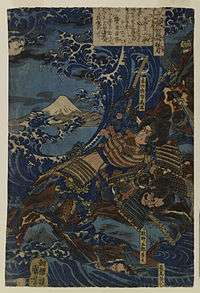Battle of Ishibashiyama
| Battle of Ishibashiyama | |||||||
|---|---|---|---|---|---|---|---|
| Part of the Genpei War | |||||||
 A 19th century depiction of combat on the rocky shore at Ishibashiyama | |||||||
| |||||||
| Belligerents | |||||||
| Minamoto clan | Taira clan | ||||||
| Commanders and leaders | |||||||
| Minamoto no Yoritomo | Oba Kagechika | ||||||
| Strength | |||||||
| 300 | 3000 | ||||||
| Casualties and losses | |||||||
| unknown | unknown | ||||||
The Battle of Ishibashiyama (石橋山の戦い Ishibashiyama no tatakai) was the first in which Minamoto Yoritomo,[1] who was to become shogun less than a decade later, was commander of the Minamoto forces. The battle was fought on September 14, 1180 in the southwest of present-day Odawara, Kanagawa Prefecture near Yoritomo's headquarters at Kamakura.[2][3]
Background
Yoritomo was exiled by Taira no Kiyomori following the Heiji Rebellion of 1160. In the following years, the Taira clan attempted to consolidate their position, eventually forcing the Emperor Takakura to abdicate in favour of his infant son, Antoku, whose mother was a Taira. Prince Mochihito felt that the throne should have been his, and in May 1180, issued an appeal to the Minamoto clan to rise against the Taira.[4]
When Kiyomori heard that Yoritomo had left Izu Province for the Hakone Pass, he appointed Ōba Kagechika to stop him. Although there was much sympathy for Yoritomo's call to arms, the clans were wary of openly supporting him and an army of only 300 gathered at Ishibashiyama where he had raised his standard. A force from the Miura clan was prevented from reaching Yoritomo by the Sakawa River which was in flood.[5]
The Battle
Kiyomori launched a night attack on the Minamato camp with 3,000 men. A further 300 under Itō Sukechika skirted around the camp and attacked from the rear. The defenders were aided by elements of Kiyomori's force who were secretly loyal to the Minamato and who could disrupt the battle without detection in the dark and stormy conditions. However, sheer weight of numbers soon told and the Minamato made a fighting retreat, culminating in a final stand by a hollow tree. When all was lost, Yoritomo is said to have hidden inside the tree trunk with a single companion. Here he was found by one of his secret allies and smuggled from the battlefield.[6] Yoritomo fled by sea from Capa Manazuru to Awa Province[7] in the south of present-day Chiba Prefecture on September 28, 1180.[2]
References
- ↑ Turnbull, Stephen (1998). The Samurai Sourcebook. Cassell & Co. p. 200. ISBN 1854095234.
- 1 2 "Shibayama-machi". Nihon Daihyakka Zensho (Nipponika) (in Japanese). Tokyo: Shogakukan. 2012. Archived from the original on 2007-08-25. Retrieved 2012-05-09.
- ↑ "Ishibashiyama". Dijitaru daijisen (in Japanese). Tokyo: Shogakukan. 2012. Archived from the original on 2007-08-25. Retrieved 2012-05-09.
- ↑ Sansom, George (1958). A History of Japan to 1334. Stanford University Press. pp. 259–260, 275, 278, 285, 289. ISBN 0804705232.
- ↑ James S. De Benneville, Saitō Musashi-bō Benkei: Tales of the Wars of the Gempei, being the story of the lives and adventures of Iyo-no-Kami Minamoto Kurō Yoshitsune and Saitō Musashi-bō Benkei the warrior monk, Published by the Author, Yokohama, 1910 (pp.28-29)
- ↑ De Benneville, (pp.29-30)
- ↑ Turnbull, Stephen (1977). The Samurai, A Military History. MacMillan Publishing Co., Inc. p. 15. ISBN 0026205408.